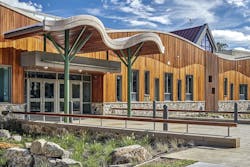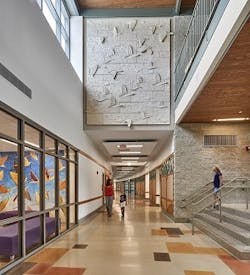Building Safer Schools That Don’t Look Like Prisons
A safe school is often thought of as a school that repels intruders and weapons, but it must be more than that. A truly safe school allows students, staff and teachers to feel safe not just during emergency situations, but normal days, too.
Unfortunately, this often translates into designs that rely on cinder blocks, heavy metal doors and imposing gates, giving the school an institutional feel. This design style is not only cold and uninviting, it’s short-sighted—the lack of windows in doors, for example, can actually make it harder for staff to spot negative behavior.
It’s time for better school design, and improving the way schools look and function starts with understanding the threats they face. Active shooters aren’t the only threat out there—there are, in fact, many factors that contribute to making schools less safe, according to Julia McFadden, associate principal with Svigals + Partners and project manager for the new Sandy Hook Elementary. These factors include:
- A growth in bullying behavior
- Lack of funding for medical and mental health services in schools
- Health insurance that doesn’t adequately cover mental health services for families
- Isolation and lack of social support for families
The physical design of a school can’t fix all of these problems, but it can support the social and emotional wellbeing of students, teachers and staff, as well as make it easier to address threats from inside and outside. Here’s how.
[Related: Best Practices for Preventing Mass Shootings in Schools]
Why Some Schools Look Like Prisons
Cold, institutional design is often the cheapest, fastest option for building a school, McFadden explained. Cuts have to be made somewhere, and materials and design are often sacrificed in the name of budgetary concerns.
“It costs a lot less to put up steel doors with no windows than it does to have glass doors and windows,” McFadden said. “When you’re hiring the architect, you’re also buying the least creative architect who might balance some of your security concerns with aesthetic concerns… Communities are unfortunately being forced into the untenable position of trying to make a good environment when the dollars aren’t there to support it.”
[Related: How Will Education Design Change in a Post-Pandemic Environment?]
How to Design Schools That Are Safe and Welcoming
It’s possible to design schools that don’t look cold and institutional without breaking the bank. Achieving this goal requires an architect with a keen understanding of children’s social and emotional development, as well as the principles of Crime Prevention Through Environmental Design (CPTED), a multi-disciplinary approach to preventing crime that relies on smart design and management of built and natural environments.
Combining these two approaches will deliver a school that’s both welcoming and secure. Consider design strategies that embrace both goals, such as:
Good grounds management. One of the major principles of CPTED is territorial management, which means defining property grounds in a clear way that makes it clear to intruders that they’ve entered the school grounds and are visible to people who are monitoring the grounds.
This doesn’t mean using an imposing, impenetrable fence, McFadden said. Rather, you can use shorter fences or strategically placed plantings that provide clear sightlines from the school all the way to the perimeter of the grounds. “Clear sightlines as you enter the school grounds, demarcating the school grounds and keeping them manicured and maintained helps deter intruders and welcomes your community,” McFadden added.
Layers of protection. Set up school entrances in a way that gives you plenty of opportunities to notice, delay and stop intruders. At the new Sandy Hook Elementary, one of the layers is a decorative gate with a welcoming leaf pattern; it includes an intercom linked to the office so that visitors have to identify themselves before they’re allowed to enter. Once they’re inside, visitors have to speak to a person before entering through a set of locked inner doors.
“Schools across the country are creating these types of entry vestibules with double-locked doors,” McFadden explained. “Once you’re in the vestibule, there’s a transaction window with a security officer or the administrative office. In [Sandy Hook’s] case, it’s similar to a bank teller window with ballistics-rated glass.”
Slightly recessed classroom doors. The doors don’t have to be exactly flush with the corridor to provide good security, McFadden said. You can recess them slightly so that the recessed doors provide visually interesting alcoves without creating a hiding place for an intruder. “Entries to classrooms are one of the design areas where we spend some time on using color and integrating bulletin boards and lighting,” McFadden said. “It makes it less institutional.”
A clear circulation pattern with orientation to the outside. “Students and adults really benefit from having a sense of where they are oriented in space,” McFadden said, suggesting touchpoints of windows to allow students to see daylight as they move through the school. “Those things are triggers for our mental health, and that helps keep the whole student body healthier mentally. With bullying, a clear circulation pattern internally also helps teachers supervise and gives cues to the students to behave better.”
Thoughtful design in the stairwell. The cheapest option is to have a metal door with no windows on the stairwell, but the lack of windows makes it easy to hide bullying, smoking or other negative behaviors there.
“Have a window in the door to the stairwell and have the door on a magnetic hold-open. The door can be propped open so a teacher walking by [can see things],” McFadden said. “When there’s an emergency, the door shuts to keep smoke from spreading into the stairwell. A magnetic hold-open is really inexpensive and helps your teachers and staff monitor students.”
Creating a community with the school’s layout. All wings of the school should feel connected to the wider school community. Disperse administrative offices, social workers and the school nurse evenly throughout the school’s layout so that there are adults to turn to in all parts of the school, McFadden advised.
Incorporating artwork. Artwork isn’t part of the CPTED principles, but it does support children’s social and emotional development, potentially helping curb negative behavior. “This can be an inexpensive thing,” McFadden said. “Most of our artwork is very economically conceived and integrated into the architecture. Other socio-emotional support devices include understanding biophilic design—for example, using natural materials that invite you to touch them that won’t be cold and harsh.”
Upgrading lighting. Fluorescent lighting is still used in many older schools, but upgrading to LED lighting can make a big difference in both energy bills and the way the school feels. “Now we understand more about how lighting affects mental health,” McFadden said. “Don’t just put the cheapest lighting in a corridor because it’s cheap and provide the minimum light level to navigate a hallway. Make thoughtful lighting decisions to make it brightly lit at the right temperature, maybe getting skylights that let daylight into your corridors or access lights at the entry to classrooms. We respond better mentally to variation in light levels.”
Welcoming, yet highly secure design doesn’t have to be a budget-buster for school districts. Smart design and thoughtful material choice can create a bright, welcoming environment that achieves the ultimate goal: keeping everyone safe at school.
About the Author
Janelle Penny
Editor-in-Chief at BUILDINGS
Janelle Penny has been with BUILDINGS since 2010. She is a two-time FOLIO: Eddie award winner who aims to deliver practical, actionable content for building owners and facilities professionals.


